South Korean brand Hifi ROSE is still a young company, having only been in business for 5 years. In this short time, however, they’ve built a solid brand image. Their first products were predominantly streamers which put a lot of emphasis on aesthetic. ROSE chose to fill the entire front panel of their connected devices with a sizeable wide-view touch screen, a decision summed up by their tagline “audio with screen”. An adapted graphics interface, similar to that offered by smartphones, means that accessing functions on ROSE devices is always simple and intuitive. We previously tested the RS201E model (https://www.qobuz.com/store-router/info/Hi-Fi/Bancs-d-essai/Rose-RS201E-A-Hi-Res-audio-and183220) with integrated amplification stage and we were impressed.
Currently, the RS150 is the brand’s top-of-the-line streamer. It provides an elegant, practical solution to accessing and playing music, all within the typical width of a HiFi device. Plus, amongst other things, it features native Qobuz integration. To complement this streamer, ROSE created the RA180 amplifier, which is visually identical in size. Whilst the streamer graces the digital world with a large touchscreen (its only interface), the RA180 is purely analog, both in its connectivity and in the way it’s controlled through multiple buttons, switches and knobs. We couldn’t wait to get our hands, and ears, on it.
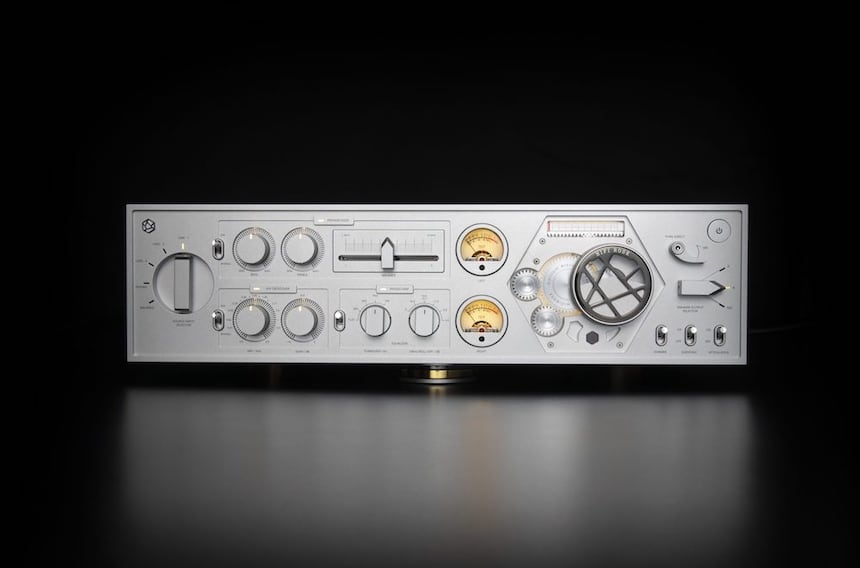
Specifications
● Integrated Stereo Amplifier
● Price : £5499
● Power : 4x200 watts or 2x400 watts at 4/8 ohms
● Damping Factor : >150
● Distorsion : 0.006 % @ 50 watts
● Signal-to-noise ratio : 108 dB (symétrique)
● Connectivity : 1x balanced XLR input, 4x unbalanced RCA inputs including 1x phono (MM/MC), 1x subwoofer output, 8x speaker terminals, IR & trigger inputs
● Other : full 2-way active filtering, IR remote control
● Dimensions (l x h x p) : 430 x 110 x 350 mm
● Weight : 16.7 kg
Overview of the ROSE RA180
The design of the RA180 stands out in the current world of Hi-Fi. HiFi ROSE are far from the only brand that’s dared to adopt a retro/vintage aesthetic, but we’ve rarely seen it taken so far. The switches and volume control definitely have a bit of a 60s Nagra vibe about them. However, the number of controls on the front panel is still unusual for an audio device, especially one this high-end.
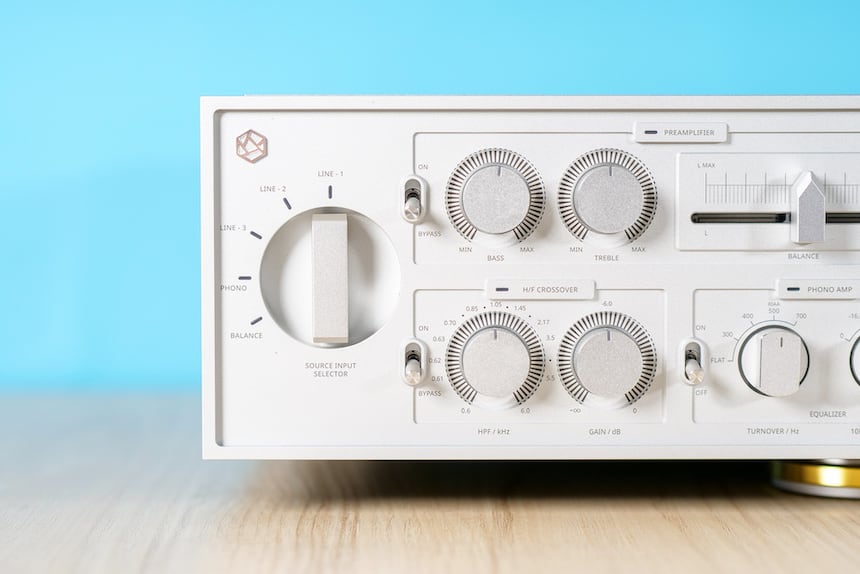
Today’s high-range audio devices strive for minimalism (excluding the small number of manufacturers who’ve instead opted for a more ostentatious approach). The ROSE RA180 amplifier keeps things simple thanks to the use of a single colour for the chassis and all controls. There are no colours or markings that are intended to stand out. Conversely, the motorised gears attached to the volume knob may seem a little excessive, but that’s part of this device’s charm – it’s got that little extra something you’ll want to show your friends.

Most controls are backlit by a yellow light, including the VU-metres and volume level indicator. Some functions can be switched off completely, in which case the corresponding buttons will no longer be illuminated. The overall lighting level can be adjusted in three increments. The soft lighting is well suited to the design of the device, with the warm lights echoing the golden, circular damping feet (custom-made by Hifi ROSE). These damping feet are based on the tripod principle, meaning there are only three of them: one centrally located at the front, and two in the back.
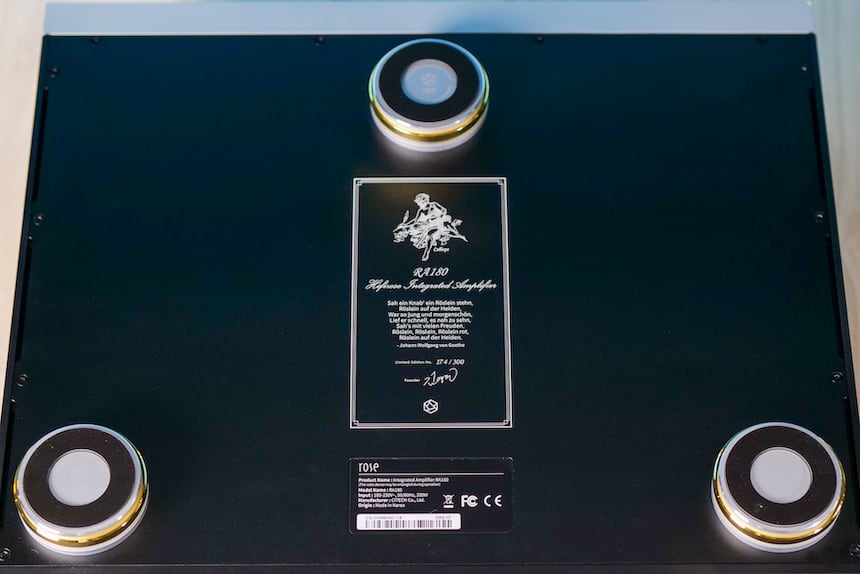
The available connections are pretty original for an integrated stereo amplifier. Usually, you’ll find a large number of sockets corresponding to the different source inputs. Here, there are only four unbalanced analogue inputs and one balanced input. There’s no digital input and therefore no DAC in the RA180. This function will need to be taken care of by a different device: either the streamer itself or a dedicated external DAC. It’s also worth noting the mono output for a subwoofer.

Perhaps the most surprising thing about the RA180 are the eight pairs of speaker terminals that occupy two thirds of the rear panel. Usually, there are two terminals for two speakers, and sometimes four terminals are used to connect two pairs of speakers in A, B or A+B mode. However, there’s twice as many here. This is because the RA180 is a four-channel amplifier which delivers 4x200 Watts at 4 or 8 ohms. This can be sent to one or two pairs of speakers using bi-amplification. The device also has a button that allows you to switch to 2x400 Watts (BTL mode) if that’s what you need, again with the option of using two pairs of speakers.

Without going into too much detail, the RA180 uses an amplification technique called Class AD by ROSE. It combines the quality and richness of Class A with the power and speed of Class D. It uses GaN FET (gallium nitride) transistors rather than the more common silicon models. The result is a significant reduction in response time and almost perfect output linearity. These circuits also cover a very wide bandwidth, up to 100 kHz, meaning the amplifier can reproduce the full range of frequencies within high-resolution files when paired with speakers equipped with super tweeters.
Using the ROSE RA180
The front panel of the RA180 is divided into distinct, well-defined areas – though you might want to take a bit of time to look at each one to familiarise yourself with what they each do. On the far left, there’s a large rotary switch which is used to select the source, i.e. one of the five line inputs. To the right, the on/off button is located above a switch that controls pure direct mode, which bypasses the various sound control stages. Below this you can choose between outputs A or B (for one or two pairs of speakers that cannot be activated simultaneously). This is also where the dimmer, subsonic filter and attenuator are located.
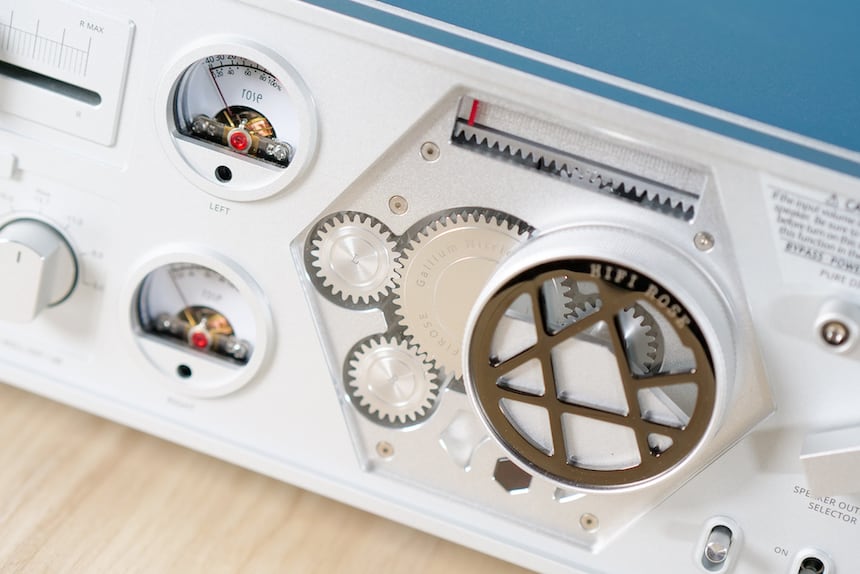
The hexagonal area contains just one single control: the volume. The potentiometer rotates a first gear that drives two other smaller gears, each corresponding to an output channel. This is also linked to another gear that indicates the volume level. Next to this, there are two gauges that indicate the input level. This allows you to check that there’s sound coming from the selected input before you start turning up the volume.

The controls in the upper centre pertain to the pre-amp functions, controlling the bass, treble and balance. An actuator on the left-hand side allows you to either activate these settings or override them. The same is true of the controls for the phono input located on the bottom centre (which is MM and MC compatible). You can choose between the two modes on the rear panel. Two dials beneath the balance control allow you to select the variable EQ: one dial controls the turnover, the other the roll-off.
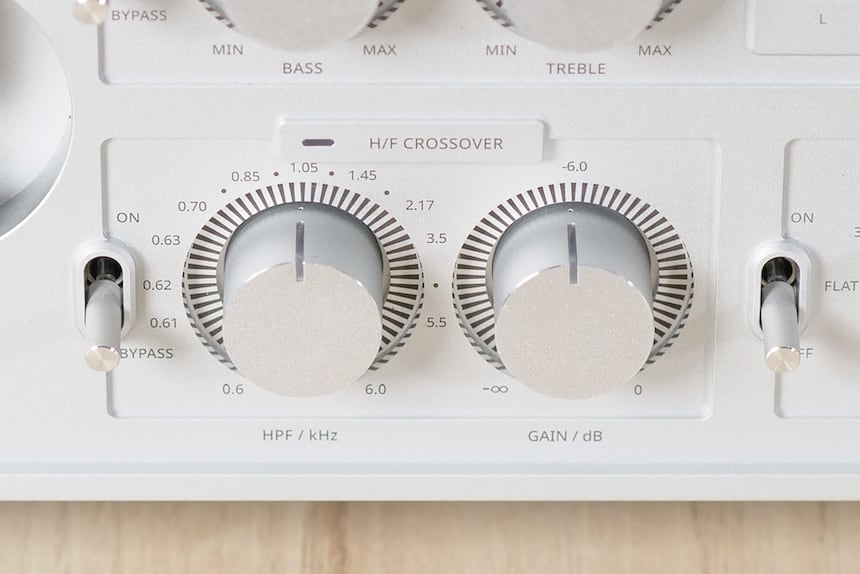
The final area in the bottom left concerns active crossover and acts on the amplified outputs. It eliminates low frequencies below a certain point, from 600 to 6,000 Hz, and adjusts the gain. These allow you to make full use of the subwoofer via the dedicated output. Crossover settings will need to be made directly on the subwoofer. There’s no difference in the active crossover between the four speaker outputs, they each receive the same frequency band. It’s the crossovers in the speakers that will separate the frequencies.

HiFi ROSE provides a small, lightweight aluminium remote control with this device. All the main controls are included so you have easy access to the essentials. You can turn the amp on and off, operate the attenuator, select one of the five inputs and control the volume. The motorised volume control and source selector is a nice touch; watching their movements from the comfort of the sofa adds a little extra something to the listening experience.
Listening Experience
We let the RA180 take centre stage in our test set-up. As a source, we used a Raspberry Pi board with RoPieee distribution, turning it into a Hi-Res Roon Endpoint-compatible player via its USB output. We needed to invite a DAC to the party, so we added a Mytek Brooklyn DAC+ which took its place between the player and the ROSE amp. We also connected our Dynaudio bookshelf speakers to the RA180.

The new expanded version of Alicia Keys’ album KEYS II has a very warm, rounded sound. The piano fills the room, establishing itself across the entire width of the soundstage. Alicia Keys’ vocals soar high, affording the soundstage that all-important verticality. The lower frequencies support the whole with impressive depth. The overall sound is condensed and airy with every instrument coming together perfectly, forming a solid centre.
Kokoroko’s Creole-accented jazz is rather calm and composed on the album Could We Be More, reminding us that the RA180 is an iron fist in a velvet glove. The volume increases quickly, so be careful to turn it up gradually to protect your speakers and your ears. There’s no deliberate emphasis here, instead, it offers a rather peaceful and relaxed reproduction of the different instruments (topped off with a welcome precision in terms of tone, making for great readability). Once again, the listening experience is fascinating; worlds apart from other HiFi devices whose surgical effects tend to disembody the music.

When it comes to bass control, the RA180 is a true master, there’s no question of that. The technology ROSE has implemented to reproduce the entire bandwidth in a linear and natural way works wonders on Hummingbird’s album, Hummingbird. The powerful bass makes a lasting impact that never falters, even when the sonic message becomes more complex. You’d be forgiven for thinking we’d turned on our subwoofer in addition to our Dynaudio speakers, but we haven’t – we double-checked. The articulation and depth create an exemplary level of accuracy: it’s pure listening pleasure.
We finished off with Anton Dvorak’s Symphony No. 7 in D minor by the Los Angeles Philharmonic. The depth of the orchestra is well conveyed with easy-to-perceive staggering and placement. The stage materialises behind the speakers and the wall behind it falls away as soon as you close your eyes. The dynamic rises make the most of the RA180’s large power reserve to bring strength and presence to each piece. The instruments converse with each other cohesively without any occlusion at the end of the notes. This amp took our speakers to their limits; it definitely wouldn’t have any issues getting the best out of more high-end models.
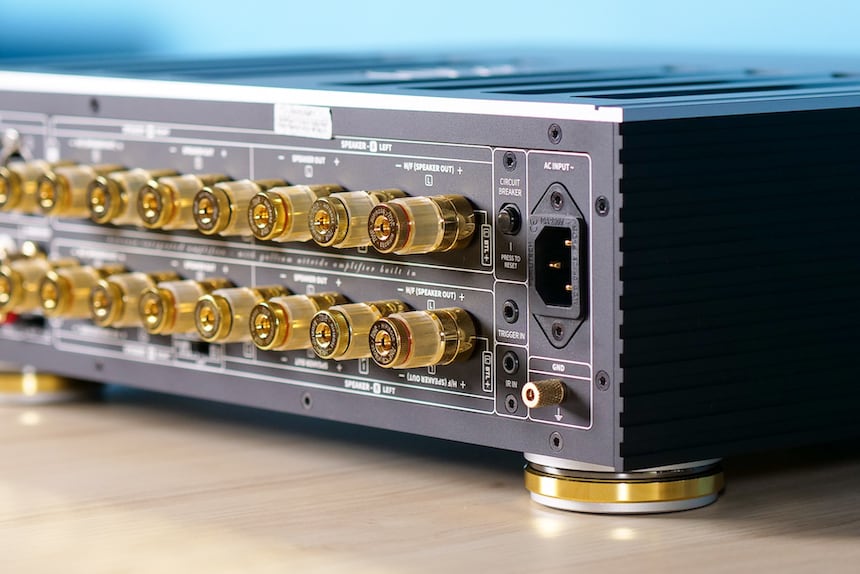
Pros :
Seemingly limitless acoustic power
Palpable presence
Ability to power all speakers
Original and practical active bi-amplification
Well thought-out settings
Cons :
Control mechanisms are a little noisy
Conclusion
The HiFi ROSE RA180 integrated amplifier will undoubtedly go down in history. Firstly, for its inimitable style which immediately identifies the brand. Though this model is daring, the risks definitely paid off because interest in the RA180 is rapidly growing. Secondly, it offers full functionality despite the fact it operates entirely within the analogue domain: configurable phono pre-amp, active crossover and four versatile amplifier channels. Finally, the sound quality exceeds expectations. The quality of the design and manufacturing combined with the choice of “AD” Class provides excellent quality, high fidelity reproduction. The soundstage is both centrally concentrated and broad whilst tones in the mid-high range are simply sublime, creating a warm sound that’s full of micro-details without ever needing extreme definition. As for the exemplary bass control, the RA180 clearly has everything covered. By deviating from its speciality (network audio playback), HiFi ROSE has produced a visually stunning integrated stereo amplifier boasting an incredible sonic performance.